WIS 80.57 Drive Authorization System
Description - Drive Authorization System
Function - Drive Authorization System
All Mercedes-Benz vehicles manufactured since about the year 2000 use a Drive Authorization System (DAS) to electronically validate the vehicle’s key. Each key fob for this system contains an EEPROM chip that stores a fixed serial number and a rolling code. Each time the key is used in the ignition switch, DAS reads both the fixed serial number and the rolling code. These values are compared to known valid values stored in DAS. If a match is found, the ECM will allow the engine to start and run, and DAS will write a new “randomized” rolling code to the key fob’s EEPROM. If the key fails validation, even if it is mechanically able to turn the ignition switch, the ECM will prevent the engine form running.
Every Mercedes-Benz vehicle has a record in FDOK (M-B’s worldwide database that contains all information about every M-B ever built), including the assignment of all electronic key codes for all vehicles using DAS.
When the record is created for a new vehicle, a set of unique key serial numbers is assigned and stored in FDOK. Only certain authorized employees at authorized PDC PDC’s (Parts Distribution Centers) have access to this information. Authorized PDC’s stock virgin key transponders and have special equipment to program them with valid serial numbers from FDOK. Keys are programmed when a key set is ordered for a new vehicle or an additional or replacement key is ordered for an existing vehicle. Only a factory or an authorized service center can order keys. For existing vehicles, the service center is required to verify that the customer ordering a key is in fact the owner of the vehicle in question. Examining the customer’s photo ID and the vehicle’s registration receipt generally satisfies this.
For new factory vehicles, there is an operation that performs the initial programming of DAS to introduce it to its assigned key set. This loads all the pre-defined key serial numbers into DAS as defined in FDOK. Even though not all keys physically exist, all possible key ID’s for that vehicle are loaded. This is performed in different ways depending on which version of DAS the vehicle uses. Once performed, there is a programming process that irreversibly locks this data into DAS. Once married to a key set, DAS will only recognize keys in that set. Officially, there is no way to reverse this process and introduce a new key set to DAS, nor is there a way to alter any of the individual key ID’s know to DAS.
For all versions of DAS, there is no battery required for the key. The battery in the key fob is used only to power the Remote Control Locking (RCL) functions. The power for the DAS functions comes from an electronic coil mounted in the ignition switch housing that supplies inductive current to the circuitry in the key fob. For some early vehicles, this coil is also used to transmit and receive radio frequency signals for reading and writing the key’s EEPROM. For later vehicles, the transfer of data between the EIS and the fob’s EEPROM is performed via an infrared signal. Also, since there is no mechanical blade to unlock the ignition switch, the release of both the ignition switch and the steering column lock is performed electronically once DAS validate the key through the infrared data exchange.
OEM Keys - Drive Authorization System
DAS has a maximum of 24 keys per vehicle, however only 8 can be active at a time. Basically for each key number, there are three key segments. The valid key numbers and segments are programmed into the virgin ESL, EIS and ECM using a special green-colored workshop key. As delivered, the vehicle will have two keys using key number 1, segment 1 and key number 2, segment 1 (some models were delivered with three keys, the third one using key number 3, segment number 1).
Typical OEM as delivered vehicle with two keys per vehicle.
- Key Number 1
- Segment 1
- Segment 2
- Key Number 2
- Segment 1
- Segment 2
Typical OEM as delivered vehicle with three keys per vehicle.
- Key Number 1
- Segment 1
- Segment 2
- Key Number 2
- Segment 1
- Segment 2
- Key Number 3
- Segment 1
Additional Keys - Drive Authorization System
When a new key is ordered, the PDC determines which key number and segment to supply based on whether the key is a replacement for a lost one or and additional spare key.
If an additional spare key is requested, then the PDC will create it as the next unused key number, segment 1. If a replacement key is requested, the technician must determine which key number was lost and order its replacement. The PDC will create the replacement with the next unused segment number for that same key number. When the replacement key is first used in the vehicle, DAS will disable the use of the key using the same key number and the previous segment. For example, if key number 2 is lost, the technician orders a replacement for key number 2 and the PDC supplies key number 2, segment 2. When this new key is used in the vehicle, this will disable key number 2, segment 1. Even if that lost key is found, it will no longer operate the vehicle. If key number 2 is lost again, the technician again orders a replacement for key number 2 and the PDC supplies key number 2, segment 3, which disables key number 2, segment number 2. If key number 2 is lost again, the PDC will supply a key with the next unused key number, segment 1, and the technician will be instructed to disable key number 2 completely using a Hand Held Tester via the OBDII port and the vehilce’s CAN. Note that RCL functions are tied to DAS so no additional programming is necessary to completely disable the remote locking/unlocking ability of a lost key.
Everything you ever wanted to know about the Drive Authorisation System (DAS), EIS and Keys
Information gathered from various official MBZ sources, included technical documentation, service documents, and even authorized technicians and factory personnel, by BenzWorld Member rudeney.
http://www.benzworld.org/forums/w163-m-class/1245088-everything-you-always-wanted-know-about.html
Remote Control Key Fob
Tip for Using Mechanical Key
Extract the Emergency Mechanical Key from the Remote Control Key Fob and after inserting into the door or boot lock, turn it all the way to the left (CCW).
Weak Batteries in Remote Control Key Fob
The Remote Control Key Fob functions may be affected by weak batteries in the key. If your key will not lock and unlock the car from 10m (30ft) or more, your batteries are weak and that will compromise the strength of the infrared (IR) beam. Try changing the batteries in the key before you go to more complicated (and expensive) efforts at restoring the function.
If the key will not turn in the ignition lock it is NOT caused by weak batteries in the key as the key electronics are powered inductively from the EIS Control Module when inserted into the ignition. See below for solutions to malfunctioning EIS.
Part Numbers - Remote Control Key Fob Batteries
- 2003 Update S500L Remote Key Fob has two batteries ie CR2025 x 2
- 2005 S500 Keyless Go Fob has only 1 Battery #2025
How To Change Batteries - Remote Control Key Fob
http://www.mbworld.org/forums/audio-...-pictures.html
Programming - Remote Control Key Fob
This video instruction is suitable for Car Key Master: CKM-100(PC Version) and CKM-200(Handhold Version), also it is suitable for Digimaster 3.
Electronic Ignition/Starter Switch (EIS or EZS) Control Module (N73)
Common Issue - Remote Control Key Will Not Rotate/Work/Turn in EIS (EZS)
Normally after inserting the correct Remote Control Key in the ignition lock (Electronic Ignition/Starter Switch (EIS) control module (N73)) it will turn instantly to position 1 (accessories), 2 (ignition on) and position 3 (engine start). However it seems that a common fault in the W220 occurs whereby the correct key will unlock the doors but once inserted in the ignition will not rotate and appears frozen. The vehicle cannot be started while the key will not turn.
Temporary Solution for Issue - Remote Control Key Will Not Rotate/Work/Turn in EIS (EZS)
The frozen key often happens intermittently causing huge frustration when out travelling. If you are lucky it may eventually start working again after continually trying and waiting twenty minutes. It is presumed that the EIS warms up slightly during this process.
Some owners have successfully used hair driers and electrical heaters to pre-warm the area around the ignition switch (EIS) to get the car started. Of course this is not a permanent fix but may get you out of immediate trouble.
Possible Failure Mechanism for Issue - Remote Control Key Will Not Rotate/Work/Turn in EIS (EZS)
It is now apparent, thanks to several BenzWorld Members and especially YouTube Poster John Kennedy, that one of the microprocessor chips on the EIS becomes sensitive to cold temperatures. Warming this particular chip temporarily solves the problem until it cools down sufficiently again. A DIY fix for this is available below.
Of course it may be that it is not the actual chip that is sensitive to cold but one or more of the solder joints connecting the chip to the board may have developed hair line cracks which open when cold and close when warmed.
Investigation of Issue - Remote Control Key Will Not Rotate/Work/Turn in EIS (EZS)
The link shows one investigation with the bottom line that it was not a DIY solution. (Later note: YouTube Poster John Kennedy shows that a DIY fix is now possible.)
- Parts of a W220 Remote Control Key
- How the Remote Control Key Works in a W220
- Diagnosing An Intermittent Key
- Testing EIS Induction Power Generator Output
- Test of Induced Voltages In Actual OEM Remote Control Key
- Removing the EIS
http://www.benzworld.org/forums/w220-s-class/1300215-cold-weather-electronic-key-problems-5.html
Replacing EIS Module
M-B Solution - Replacing EIS Module
The easiest but extremely expensive solution is to replace the EIS with a new one. It will cost over $3,000 and requires reprogramming of the new EIS to match the vehicle. As this is deemed a safety/security issue it can only be done by an authorized M-B agent.
DIY Solution No. 1 - Less Expensive Solution for Complete EIS Replacement
In Australia it is not necessarily a Dealer only option any more.
On line parts supplier Genuine Auto Parts will sell an EIS to the public for about AU$625 and Mercedes-Benz will supply a green (workshop) key with a AU$500 deposit, refunded on return of the key.
DIY Solution No. 2 - Replacing EIS Microprocessors
With a huge acknowledgement to YouTube Poster John Kennedy (and BenzWorld Member pinkster, Dean, for discovering the video) whose excellent diagnosis shown in the video referenced below positively demonstrates a faulty microprocessor which caused his issue.
In his case the fault was due to the lower Hc08 microprocessor chip (4j74y), shown in the next figure.
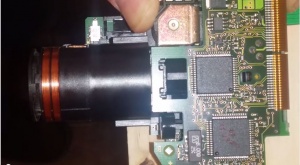
This microchip was very sensitive to cold temperature, shown here being cooled with a can of freezer solution. Once cooled the key freezes in the lock and will not turn.
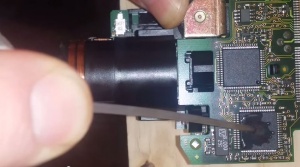
Warming the culprit chip, just with applied finger warmth for a few seconds, solves the issue and the key will turn again.
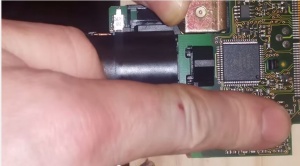
John Kennedy reports that the issue was fixed by replacing the faulty microprocessor.
Warning
Be aware that in other cases it may not be the microprocessor chip shown in this article that fails but could be other components or even the solder joints themselves so some diagnosis as per the video will be necessary to thoroughly isolate the faulty component or item.
Also be aware that working with electronic components requires some specialized skills such as fine soldering technique and appropriate earthing techniques to aid in prevention of electrostatic discharge. Surface mount electronic components can be very sensitive to excess heat and static electricity.
Replacement microprocessor chips are available but will require the original programme to be copied to the replacement chip which requires some speciallised equipment and knowledge.
Any comments on how the reprogramming is done would be appreciated, especially by some one who has successfully completed the DIY fix of an EIS.
Part Numbers - EIS Microprocessors
The part numbers for the microprocessors in the EIS from a 2003 (Update) W220 S500L are:
- The 64-pin quad flat pack (QFP) microprocessor at the bottom location in the figures above has the following information on its face.
- 00198128A3
- EWM
- Motorola Logo
- SC510108CFU
- 4J74Y
- QQCF0305
- 06/03 R2
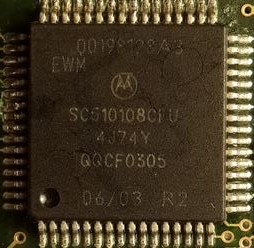
- The 64-pin quad flat pack (QFP) microprocessor at the top location in the figures above has the following information on its face.
- 001981287A
- Motorola Logo
- SC510108CFU
- 4J74Y
- QQCV0309
- 20/03 R1
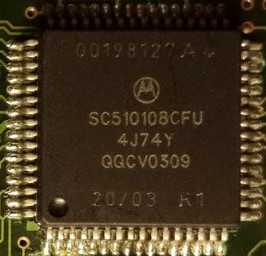
Parts Availability - EIS Microprocessors
With thanks to BenzWorld Member pinkster, Dean these microprocessors are available for about US$30 posted from this source. [1]
DIY Solution No. 3 - Replacement EIS via eBay
Australian BenzWorld Member iSteve reported that he purchased a replacement EIS with the same part number as his on eBay from the USA.
He was advised by his Indie that the US uses the same key frequency as Australia and hence the USA sourced EIS would be compatible with the Australian standards.
Initially the Indie only "cloned" one EPROM which resulted in some errors such as;
- A side marker lights error as Australian delivered cars do not have side marker lights.
- The Steering Wheel Comfort feature would not work.
- The odometer reading of the new unit was incorrect and unfortunately was higher than the original.
iSteve reported that his Indie used an In Circuit Serial Programming (ICSP) cloning tool and a laptop which allowed programming a microprocessor chip while it is still attached to the application circuit. That is there is no need for chip swapping.
The ICSP tool was used to save the original Hex files and copy them over to the replacement EPROMs. There were 88 differences between the old and the replacement unit.
After a second attempt whereby both "EPROMs were cloned" the new unit is working the same as the original but with no cold start problem.
Reference [2]
DIY Solution No. 4 - "The Ultimate EIS Repair Guide"
MHH Auto senior member 'bawarek' has posted an excellent although very technical article titled, "The ultimate Mercedes EIS repair guide".
See http://mhhauto.com/Thread-The-ultimate-Mercedes-EIS-repair-guide